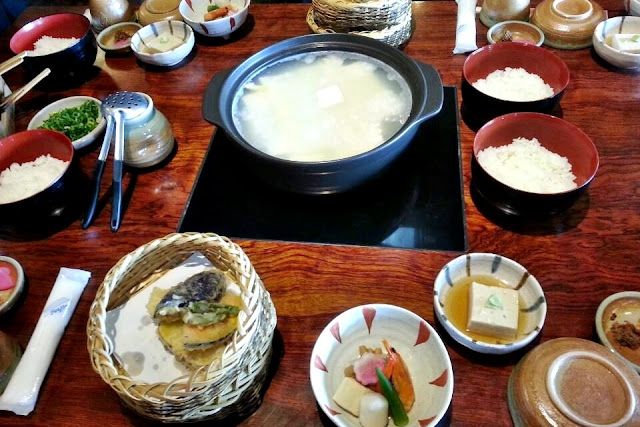Arrived at Kiyomizu, we're guided to restaurant for lunch before going to the temple...

Kiyomizu Junsei Okabeya Tofu Restaurant (清水順正おかべ家).
Yodofu (湯豆腐) is one of the famous dishes in Kyoto. Originated as temple food (shojin ryori) to substitute protein source from meat or fish, Buddhist priests in Kyoto using tofu as precious source of protein. It's simple in preparation too by simmered Tofu in earthenware pot (donabe) with hot water (Yu).
Rustic restaurant in the heart of busy Kiyomizu Street. (photo source)
I think the whole restaurant was booked to cater for our group lunch.
For our team, we were placed on this second floor dining hall.
All of the dishes were prepared on the tables before we arrived.
For our team, we were placed on this second floor dining hall.
All of the dishes were prepared on the tables before we arrived.
Each table has a big earthen pot of Youtoufu for 4 persons servings.
Individual set for vegetable tempura, shrimp, sakura yam, pickles, sesame tofu and...

yummy grilled soy bean paste on tofu
skewer (Dengaku).
Fresh vegetables and local traditional handmade tofu dominate the menu in Kyoto, making it one of the healthiest
cuisines in the world.

京都の大晦日の夜は、祇園さん(八坂神社)にオケラ火を貰いに行きます。
神宮は暮の二十六日、桧にキリを立て浄化をもみだし、御神火として一年中絶やさず本殿にともします。大晦日の夜、この火にあざみに似た薬草であるオケラを焚き、これを神前のオケラ灯篭に移します。
人々は神前に詣で、オケラ灯篭から火縄に浄火を貰います。
消えぬよう振り回しながら急いで家に持ち帰り、神棚の灯明に移します。
また、この火で煮た元旦の雑煮を食べると疫除けになると云われています。
大晦日の深夜、神社で焚かれる火は先祖霊の象徴です。
オケラ火は先祖の霊で、新年の火は神聖なものでなければならないとする古い信仰に由来するものです。(source)
Philosophy of Kyo-ryori (京料理 = Kyoto Cuisine) translates to:
* Bring the natural taste of seasonal ingredients ‘to life’ by using minimal seasoning.
* Avoid excessive heat and not overcooking.
* Present the food beautifully according to the season.
Yudofo is the best example that bring out the spirit of Kyo-ryori.
You can enjoy this classic Zen cuisine on its own after scoop it out from the pot to taste the light and smooth texture of Yudofo.
Our guide suggested us to dip a bit of soy sauce and garnish it with spring onion, ginger as condiments.
Guides were busy asking red pepper flakes from the restaurant as most of the tour members mainly from Indonesia and Malaysia. They simply can't eat food without chilly and love rich flavored food. So to them even after garnished it, yudofu still tasteless or too bland.
Actually, the main focus of this dish is the elegance of its simplicity and enjoying the purity and delicate flavor of yudofu.

Quickly finished our lunch and went out to inhale fresh air downstairs.
It's too chaotic inside the restaurant, especially with one attention seeker uncle
keep walking around and whistling beside me. He even purposely screamed
'Ho I Si' (let him die) to the Japanese cameramen, when the cameramen nicely
asked us to say 'Oishi' (delicious). Haiz... no comment!
Fountain pond outside the restaurant.
Healthy and nutritious tofu also one of the staple ingredients in Korean cuisine.
In fact, the plainness of Yudofu quite similar to Chodang Sundubu (초당순두부) that we tasted in Korea. But watery Chodang Sundubu is more like crushed tofu instead of cube shape. It's also traditionally handmade, prepared from locally grown soybeans and seawater in Gangneung.
We also like Sundubu-jjigae (순두부찌개). This spicy silky tofu stew usually cooked with sour kimchi meat or seafood, vegetables and egg indeed very tempting and tasty.

Kiyomizu Junsei Okabeya (清水順正おかべ家).
Website: http://okabeya.com
Add: 239 Kiyomizu 2-chōme, Higashiyama-ku,
Kyōto-shi, Kyōto-fu 605-0862, Japan
Tel: +81 75-541-7111
Operating hours: Mon - Sun (10:30 am - 5:00 pm)






No comments:
Post a Comment